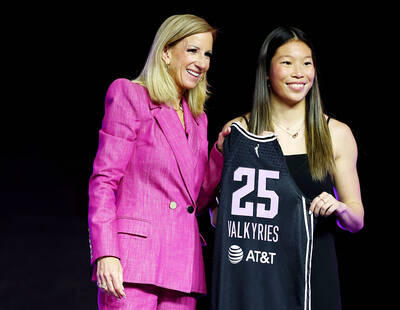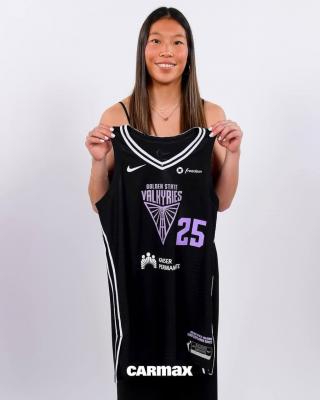For ESPN, the inexorable result of 26 years of feeding sports to millions of people and fueling fans' desires for ever bigger screens is surprisingly small.
It is, in fact, really small, yet designed to drive the supersized ESPN brand further into the sports zeitgeist.
ESPN has crammed everything it has learned about television into the guts of a black Sanyo cellphone with red keys and a 2.1-inch screen that dishes out scores, highlights, news, trivia and fantasy content with depth and zippy clarity. In time, it will deliver full games shrunk to 1/15th or 1/20th their usual television size.
This is Mobile ESPN, an empire in a pocket, a digitally endowed companion with a tiny Dickie V. or a wee Chris Berman available at a button's push for those minutes and hours spent away from one's television.
"What's next, implants?" said Keith Olbermann, a former anchor of SportsCenter who is now the host of MSNBC's weeknight Countdown show. "They were once bound by cable. It was a cable success. Now, they're detaching from cable. Just jam it in your pocket, and you're ESPN."
The idea behind Mobile ESPN was to make the omnivorous sports media empire more available than it already was by merging what fans expect on TV and online at ESPN.com into a pre-eminent third screen in sports.
"Our mission is to be everywhere fans watch, talk, debate and enjoy sports," said Salil Mehta, executive vice president of ESPN Enterprises. "We don't believe in one screen. We believe in all three."
It was Mehta, then an executive with Walt Disney Co, which owns 80 percent of ESPN, who suggested last year that ESPN develop a cell phone. Eventually, ESPN would customize an expensive cellphone with Sanyo, and sign with Sprint Nextel to carry the service on its high-speed network.
"Life will never get in the way of sports again," Mehta said, echoing a planned advertising campaign.
ESPN's aspirations have grown as the cell phone market has matured; there are 194 million wireless phone users in the US. "For ESPN, it means trying to get people to leave another carrier, and the way to do it is with something different," said Linda Barrabee, a senior analyst at the Yankee Group, a technology research firm. "The market is primed for differentiation."
ESPN's desire for cellular success is part of its yen for sports-world primacy. In 1979, few could envision the growth of ESPN into a media behemoth that inspires awe, jealousy and contests to be a SportsCenter anchor." But one ESPN network begat many more; a radio network was created; so were ESPN.com, the most visited sports Web site; a magazine; a restaurant chain; trading cards; and books.
Along with it all came the highest monthly subscriber fee for any basic cable channel, ferocious marketing, an enormous cash flow and a healthy ego. An online Mobile ESPN ad proclaims that the new phone is: "The Greatest Invention in the History of the World. Ever."
Hyperbole aside, ESPN says that getting into the cellular business is a necessary step to serve its audience beyond continuing to feed its sports data to Verizon, Sprint, Cingular and T-Mobile wireless customers.
"This is a time when consumers want whatever they want wherever they want it on the device they want," said John Skipper, ESPN's executive vice president for content. "It's no longer about just sitting in front of the TV."
Time was, tube-gazing was what ESPN and television were all about, but computers, the Internet, cellphones, digital video recorders and iPods have transformed how and when people view television, regardless of the set's size.
Manish Jha, the senior vice president of Mobile ESPN, said, "The idea is to create an immersive experience" that looks and sounds like ESPN, that offers familiar content, music and personalities in a hand-held form.
The ESPN experience is reachable through one click on the phone, and advances into an easy-to-navigate sports universe of colorful graphics and clear video clips created in ESPN's digital center in Bristol, Conn. Close-ups are preferable to long shots on the small screen to enhance the clarity of video that currently transmits at about half the speed of regular television.
"We wanted a total sports ecosystem," Jha said.
Rarely has television been described in terms more suited for Jacques Cousteau. But sports fans have for decades made ESPN one of their natural habitats. ESPN estimates that 97 million people "touch" (for at least 10 minutes) one of its services each week.
Mobile ESPN is simply the latest way to expand its well-used ecosystem while simultaneously serving the traditional sofa and barstool set.
Expecting people to watch three-hour games on a 2.1-inch screen is not a major concern or an opening strategy for the cellular ESPN. Officials believe that users will usually dip in and out for a few minutes at a time, and that long-form live events will in time attract an audience.
ESPN has been amassing wireless rights to games for several years, but it is working on the technology required to transmit the games from cell towers to phones.
"I think some customers will watch, but who will and how many?" Mehta said. "And what's the right package?" Whether users will pay extra to watch Monday Night Football or Sunday Night Baseball has not been decided.
Robert J. Thompson, director of the Center for the Study of Popular Television at Syracuse University, said that in pursuing the mobile option, ESPN has recognized the portability of sports content.
"In an age when we're offered bigger, wider, more definition screens, sports works perfectly in airports, doctors' waiting rooms and commuting on trains," he said. "Fans want wider screens to watch sports in all their glory, but it's not a contradiction that they can watch wherever they are."
It will be costly to watch, or touch, Mobile ESPN. It is selling at Best Buy stores in four test markets for US$399.99 after a US$100 rebate; monthly service costs from US$64.99 to US$224.99. Sometime before Christmas, the phone is expected to be sold on ESPN.com; soon after Best Buy's full retail beginning in February, lower-priced handsets will be available.

College basketballer Kaitlyn Chen has become the first female player of Taiwanese descent to be drafted by a WNBA team, after the Golden State Valkyries selected her in the third and final round of the league’s draft on Monday. Chen, a point guard who played her first three seasons in college for Princeton University, transferred to the University of Connecticut (UConn) for her final season, which culminated in a national championship earlier this month. While at Princeton, Chen was named the Ivy League tournament’s most outstanding player three times from 2022 to last year. Prior to the draft, ESPN described Chen as

College basketballer Kaitlyn Chen (陳凱玲) has become the first player of Taiwanese descent to be drafted by a WNBA team, after being selected by the Golden State Valkyries in the third and final round of the league's draft yesterday. Chen, a point guard who played her first three seasons in college for Princeton University, transferred to the University of Connecticut (UConn) for her final season, which culminated in a national championship on April 6. While at Princeton, Chen was named the Ivy League tournament's most outstanding player three times from 2022 to last year. Prior to the draft, ESPN described Chen as a

Japan yesterday secured a second consecutive Billie Jean King Cup finals appearance with a 2-1 win over 2023 champions Canada, thanks to Ena Shibahara and Shuko Aoyama’s 6-3, 5-7, 6-2 win over Kayla Cross and Rebecca Marino in the qualifying doubles decider. Shibahara and Aoyama powered through the opening set 6-3, breaking twice for a quick 3-0 lead. Cross and Marino hit back in the second, edging it 7-5 to level the match, before the Japanese pair regained control in the third. Canada’s 18-year-old Victoria Mboko edged Shibahara 6-4, 6-7 (8/10), 7-5 in a marathon opening clash. Mboko fired eight aces to

DAY OF BLOWOUTS: Elsewhere, the Lakers clinched the third seed in the Western Conference with a 140-109 pounding of the under-strength Houston Rockets The Denver Nuggets on Friday improved their playoff position, with a triple double from Nikola Jokic helping them to a 117-109 win over the Memphis Grizzlies. The Serbian put up 26 points, 13 assists and 16 rebounds. The triple-double performance, his 34th this season, ensured that he will finish the regular season as just the third NBA player to average a triple double across an entire season. The win meant the Nuggets improved to 49-32 on the season and gave them a real chance of grabbing fourth place and home-court advantage in the playoffs. Aaron Gordon top scored with 33 points for Denver,